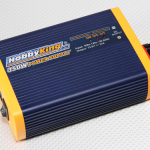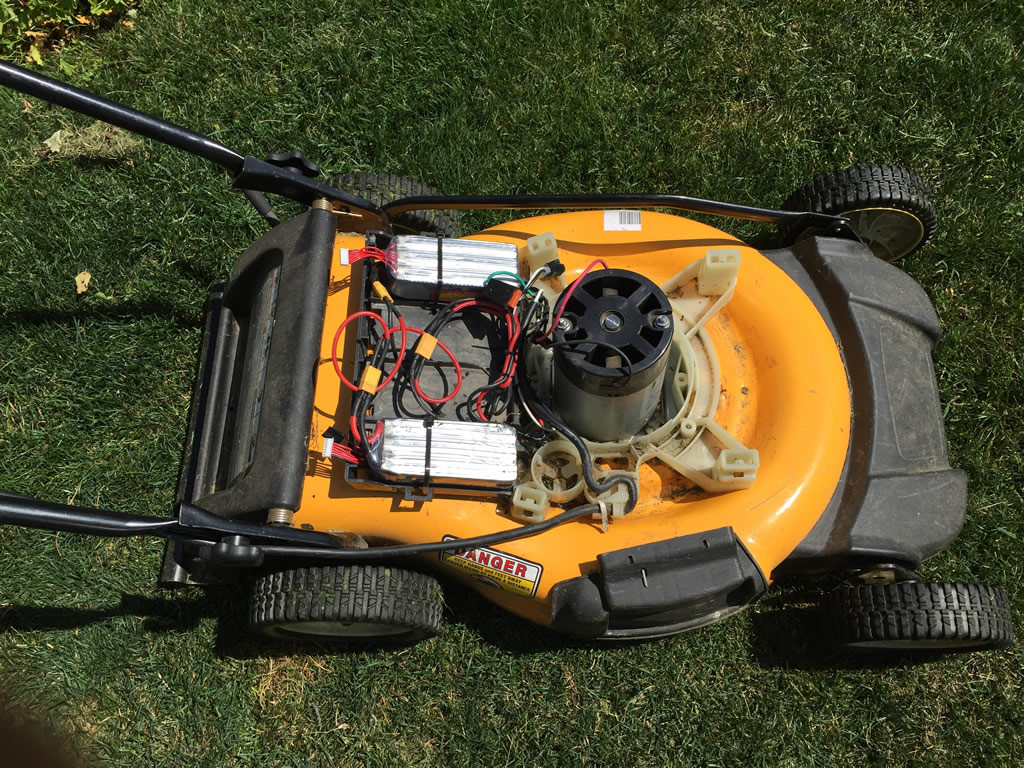CubCadet CC500 Electric Mower – LiPo Battery Conversion
 I decide to go the electric mower route about 5 years ago. I was hesitant as the 12V lead-acid batteries most electric mowers come with suck – and they are heavy. At that time, the only better technology was Lithium Ion battery-based mowers, but they were very expensive. I decided on the CubCadet CC500, which was a good balance of quality and price. It was a 48 Volt lead-acid unit.
I decide to go the electric mower route about 5 years ago. I was hesitant as the 12V lead-acid batteries most electric mowers come with suck – and they are heavy. At that time, the only better technology was Lithium Ion battery-based mowers, but they were very expensive. I decided on the CubCadet CC500, which was a good balance of quality and price. It was a 48 Volt lead-acid unit.
It only took 2 years for the (4) original lead acid batteries to waste away. I was stuck between going back to gas, or replacing batteries. I let myself go somewhere in between by only replacing 2 of the 4 batteries with new lead acid units. That only lasted a season and I soon found myself charging the batteries twice for each mow. To add insult to injury, our new patio further reduced the cutting area – yet I still needed 2 chargers per cut! I needed a solution…
After getting into RC quads, I realized the solution was right there in front of me with the Lithium Polymer batteries I’m using for my quads. They are the perfect combination of power/weight and longevity. After doing some math, I figured I needed approx 10000 mAh of juice which would give me about 40 minutes cut time (48V @ 550 Watt motor). LiPo batteries can be expensive, so I decided to go low risk route and start with 2 x 22.2 Volt 5200 mAh batteries ($100 each). This gave me ~45 Volts @ 5200 mAh (series connected) – which would give me ~20 minutes cut time. Another bonus was that LiPo’s have a nice power to weight ratio, so I gained some significant weight savings with this new set-up. The CubCadet wiring design is straight forward, and I was able to hack the LiPo’s into it quickly while also maintaining the existing circuitry (i.e. the safety switch, overload fuse etc).
Results:
The results are impressive. After being on vacation for a week-and-a-half, the grass got pretty tall. The new set-up cut through it with ease and power – even the denser damp grass. I’ve got to do a few more cuts over the next few weeks to get more concrete results, but I don’t think I need to add more batteries (I had originally banked on about 10000 mAh). This mod cost about $250 CAD in parts. For many, this could be viewed as a waste since you can get a gas mower for that much. However, I expect to get a few hundred mows out of these batteries. To me, the cost justifies the benefits (environmentally sound, quiet, lighter (than both gas and a lead-acid set-up), long lasting, faster charging, no pollution). I figure I will get at least 5 seasons out of this.
Update: Sept 2017 – Well, 2 years out, and the system has been working well. Unfortunately, both batteries had a cell go dead on me, so I need to get some new batteries. I’ve chalked it up to cheap batteries with poorly cells.
Update: I just completed another cut and the system performed great. Batteries maintained good power through the entire cut as well as heavy parts. I was even able to take the mower into the valley and clear a path through 4 foot weeds down to our garden. When I was done, it still had plenty of juice.
Update Aug 22: Very happy with the results. I am averaging about 2 cuts per charge on the 5200 mAh set-up, so I don’t expect to be adding batteries as this works for me.
[ad name=”GoogleAS728x90ImgOnly”]
Sound Byte:
Some folks have asked for a video of the sound of the mower. Given it was an electric mower when I started the mod, there is no real difference in switching over to LiPo’s. Electric mowers are pretty quiet to start. I can mow and have a conversation with someone no problem. That said, here’s a video clip of the sound with some SPL numbers. In short, it registered @ 120dB. That’s pretty significant, but keep in mind the tablet was 1 ft way from the motor/blade.
Next step – Charge / Power Switching:
Otional: One of the challenges I knew would be a pain was charging the batteries. I didn’t want to connect/disconnect the batteries each time I wanted to charge them. The set-up is further complicated because in “power” mode, the batteries are in series. In “charge” mode, they need to be in parallel. I wanted a means where I didn’t have to remove any connections. Instead, I came up with the below switching circuit using a switch. This would allow me to switch it between power and charging modes with ease.
The concept is pretty straight forward. A DTDP switch is used to flip between charge and power (mowing) modes. I also checked the circuit for potential shorts or fails should things be hooked up wrong (i.e. switch in power mode with charger plugged in) and it’s all good.
Note: this has not yet been tested as I never got around to building it.
 |
 |
 |
Hardware:
- 22.2 Volt LiPo Battery (You will need 2 batteries in series = 44.4 Volts) (other options)
- XT60 Series Battery Connection Cable
- Tarot Para Board TL2716 Lipo Parallel Charger Board
- 6s Extension Cables
- Charge Switcher (optional) Double Pole Double Throw Switch
- 12 Gauge Wire
- Various XT60 M/F connectors
- Turnigy Mega 400W Charger (or something similar)
- HobbyKing 350W Power Supply
You will also need a charger and charge power supply. Something capable of pushing a lot of Amps. For my set-up, I’m parallel charging at 10.4 Amps using the Parot parallel charging board. You can look here, or check Hobbyking for their selection.
 |
 |
 |
 |








You are a genius.
I assume a 30,000mah battery like this (https://store.boingboing.net/sales/zerolemon-toughjuice-30000mah-battery-pack) wouldn’t work because it couldn’t deliver power at the rate needed? Not able to deliver enough volts?
Yes, that is correct. Those devices are built to provide multiple charging cycles to small devices @ 5 Volts.
Do you have any idea what the maximum power is for this motor. I’ve seen one in the classifieds for $20 and have batteries I could use to run it?
The motor is 48V 550 Watts
How did the lawnmower perform since you did the modifications ? I am planning to do exactly as you did since I own the exact same model.
The mower is still working great.. I get 2.5 cuts per charge – which is far better than the crappy lead acid batteries gave me. My only suggestion is to make the battery power leads longer. Im going to get some heavy gauge silcone RC wire and make some extensions.